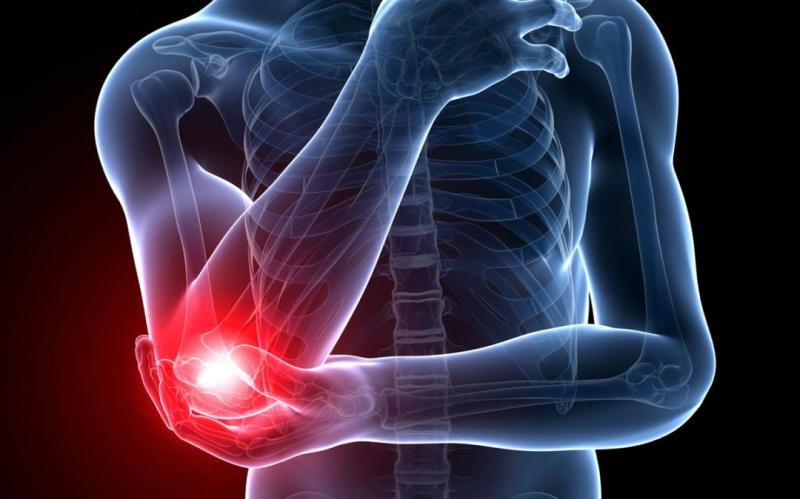Mitigate Pain Clinic – Dr Jeshnu Tople – Pain Management Specialist In Nagpur
Meet Our Doctor

INTERVENTIONAL PAIN AND SPINE SPECIALIST
Dr. Jeshnu Tople
MBBS, DA, DNB, FIAPM, FIPM, FIPP (USA), EDPM (Belgium)
- MBBS from Wardha, Maharashtra
- Diploma in Anaesthesiology from Wardha, Maharashtra
- DNB (Anaesthesiology) from New Delhi
- Fellowship in Pain Management (affiliated to Aesculap Academy, Germany)
- Fellowship of Indian Academy of Pain Medicine from Daradia Pain Hospital, Kolkata
Our Testimonials


Ishan Gadekar

Srujan Topale

Golfer’s Elbow In Nagpur
Golfer’s Elbow Treatment in Nagpur:
Golfer’s elbow, or medial epicondylitis, is a painful condition that affects the inner side of the elbow. Despite the name, this condition is not limited to golfers; it can occur in anyone who performs repetitive arm and wrist motions, such as weightlifters, tennis players, or people who engage in manual labor. If you’re dealing with golfer’s elbow in Nagpur, effective treatment options are available to help you recover and return to normal activities pain-free.
What is Golfer’s Elbow?
Golfer’s elbow occurs when the tendons on the inner side of the elbow become inflamed or injured, often due to repetitive stress or overuse. It is caused by the strain placed on the tendons that attach to the medial epicondyle, the bony bump on the inside of the elbow. This condition can lead to pain, tenderness, and weakness in the elbow, forearm, and wrist.
Common Symptoms of Golfer’s Elbow
- Pain or tenderness on the inner side of the elbow
- Pain that radiates down the forearm
- Weakness in the hand or wrist
- Pain that worsens with gripping, lifting, or bending the arm
- Pain while performing everyday activities, such as shaking hands or turning a doorknob
- Stiffness and reduced range of motion in the elbow
If you experience any of these symptoms, it is important to seek professional help to prevent the condition from worsening.
Causes of Golfer’s Elbow
Golfer’s elbow is caused by repetitive movements that strain the tendons on the inside of the elbow. The following factors may contribute to the development of this condition:
- Sports: Golf, baseball, tennis, and other sports that involve repetitive arm or wrist movements.
- Occupational Activities: Jobs that require repetitive motions, such as construction, painting, or plumbing.
- Overuse: Repeating the same motions over time, especially those involving gripping, twisting, or lifting.
- Age: Golfer’s elbow is most common in people between the ages of 30 and 50.
- Improper Technique: Using incorrect form during sports or physical activities can increase the risk of developing golfer’s elbow.
Effective Golfer’s Elbow Treatments in Nagpur
If you’re suffering from golfer’s elbow in Nagpur, there are several treatment options that can help reduce pain, promote healing, and restore your strength and mobility.
1. Physical Therapy
Physical therapy is a highly effective treatment for golfer’s elbow. A skilled physiotherapist in Nagpur will guide you through exercises to strengthen the forearm muscles, improve flexibility, and reduce strain on the tendons. This approach helps prevent further injury and promotes long-term healing.
2. Medications for Pain Relief
Nonsteroidal anti-inflammatory drugs (NSAIDs) such as ibuprofen can be helpful in reducing pain and swelling caused by golfer’s elbow. In some cases, doctors may recommend stronger pain medications or corticosteroid injections for more severe pain.
3. Rest and Activity Modification
One of the most important steps in treating golfer’s elbow is rest. Avoid activities that put stress on the elbow, such as gripping or lifting. Modifying your activities and taking frequent breaks can help prevent further irritation and allow the tendons to heal.
4. Ice and Heat Therapy
Applying ice to the affected area can help reduce inflammation and numb the pain. Heat therapy, such as warm compresses, can help improve blood circulation and relax the muscles. Both ice and heat can be used in conjunction for maximum relief.
5. Elbow Braces or Supports
Wearing an elbow brace or support can help stabilize the elbow joint, reduce strain on the tendons, and provide relief during daily activities or sports. These devices are particularly useful during the initial stages of recovery.
6. Platelet-Rich Plasma (PRP) Therapy
PRP therapy involves using a concentrated solution of your own platelets to promote healing in the damaged tendons. This innovative treatment has shown great promise in treating golfer’s elbow and other tendon injuries. PRP therapy is available in Nagpur and can help accelerate the healing process.
7. Extracorporeal Shockwave Therapy (ESWT)
Shockwave therapy is a non-invasive treatment that uses sound waves to promote healing in the affected tendon. This treatment is especially effective for chronic cases of golfer’s elbow that do not respond to traditional methods.
8. Surgery
In rare cases where conservative treatments do not provide relief, surgery may be considered. Surgical options may involve tendon repair or removal of damaged tissue. However, surgery is generally considered a last resort.
Why Choose Golfer’s Elbow Treatment in Nagpur?
Nagpur is home to a number of highly skilled orthopedic specialists and physiotherapists who are experts in treating conditions like golfer’s elbow. With access to modern diagnostic tools, advanced treatments like PRP therapy, and a variety of rehabilitation options, residents of Nagpur can find effective solutions to their elbow pain.
At-Home Management for Golfer’s Elbow
While professional treatment is essential, there are several at-home strategies you can use to manage golfer’s elbow:
- Rest: Give your elbow time to heal by avoiding activities that exacerbate the pain.
- Ice: Apply ice to reduce inflammation and numb the pain.
- Compression: Use an elastic bandage or elbow brace to reduce swelling and provide support.
- Elevation: Keep your elbow elevated to reduce swelling.
- Gentle Stretching: Once the pain subsides, perform light stretches to improve flexibility and strength.
When Should You Seek Medical Attention for Golfer’s Elbow?
If your symptoms persist for more than a few weeks, worsen over time, or significantly impact your daily activities, it’s important to seek medical attention. A doctor or specialist in Nagpur can provide a comprehensive diagnosis and develop an individualized treatment plan tailored to your needs.
Conclusion
Golfer’s elbow can be a painful and debilitating condition, but with the right treatment, it is possible to recover and return to normal activities. Whether through physical therapy, medications, PRP therapy, or surgery, there are effective solutions available in Nagpur. Don’t let golfer’s elbow stop you from enjoying your favorite activities—seek professional help today and begin your journey toward recovery. Visit Our Hospital.

FAQ's For Golfer’s Elbow In Nagpur
- Golfer’s elbow, or medial epicondylitis, is a condition that causes pain on the inner side of the elbow due to inflammation of the tendons. It often results from repetitive arm movements or overuse.
Golfer’s elbow is caused by repetitive stress or overuse of the forearm muscles and tendons. It can occur from playing sports like golf, tennis, or baseball, as well as from repetitive activities such as typing, painting, or lifting heavy objects.
Symptoms include pain or tenderness on the inner side of the elbow, weakness in the forearm, pain while gripping objects, pain that radiates down the forearm, and difficulty with everyday activities like shaking hands or turning a doorknob.
Yes, while Golfer’s elbow usually affects one arm, it can occur in both elbows, especially if repetitive activities are performed with both arms.
A doctor typically diagnoses Golfer’s elbow through a physical examination. They may perform tests to assess the strength, flexibility, and pain levels of the elbow. In some cases, imaging tests such as X-rays or MRIs may be used to rule out other conditions.
No, Golfer’s elbow is not limited to golfers. It can be caused by any activity that involves repetitive stress or strain on the tendons of the inner elbow, including tennis, weightlifting, and manual labor.
Recovery time varies depending on the severity of the condition and the treatment methods used. Most people recover in 6 to 12 weeks with conservative treatment, but more severe cases may take longer.
It is advisable to rest and avoid activities that worsen the pain. Continuing sports or activities that strain the elbow could delay recovery and make the condition worse.
Common treatments include rest, ice therapy, anti-inflammatory medications, physical therapy, elbow braces, corticosteroid injections, and Platelet-Rich Plasma (PRP) therapy. Surgery may be needed in rare cases if conservative treatments do not work.
Physical therapy involves exercises designed to stretch and strengthen the muscles of the forearm and elbow. It helps improve flexibility, reduce pain, and prevent future injuries.
Our Treatments
- Joint Pain
- Back Pain
- Sciatica Pain
- Neck Pain
- Hand Pain
- Shoulder Pain
- Foot & Ankle Pain
- Limb Pain
- CRPS Pain
- Cancer Pain
- Headache
- Hyperhidrosis
- Herpes Zoster Pain
- Chronic Pelvic Pain
- Scar Tenderness
- Postherpetic Neuralgia
- Trigeminal Neuralgia
- Peripheral Neuralgia
- Chronic Vascular Pain
- Generalised Body Pain
- Chronic Injury Pain
- Failed Back Surgery Syndrome
- Chronic Post Surgical Pain
- Other Painful Conditions
- Slipped DISC / PIVD